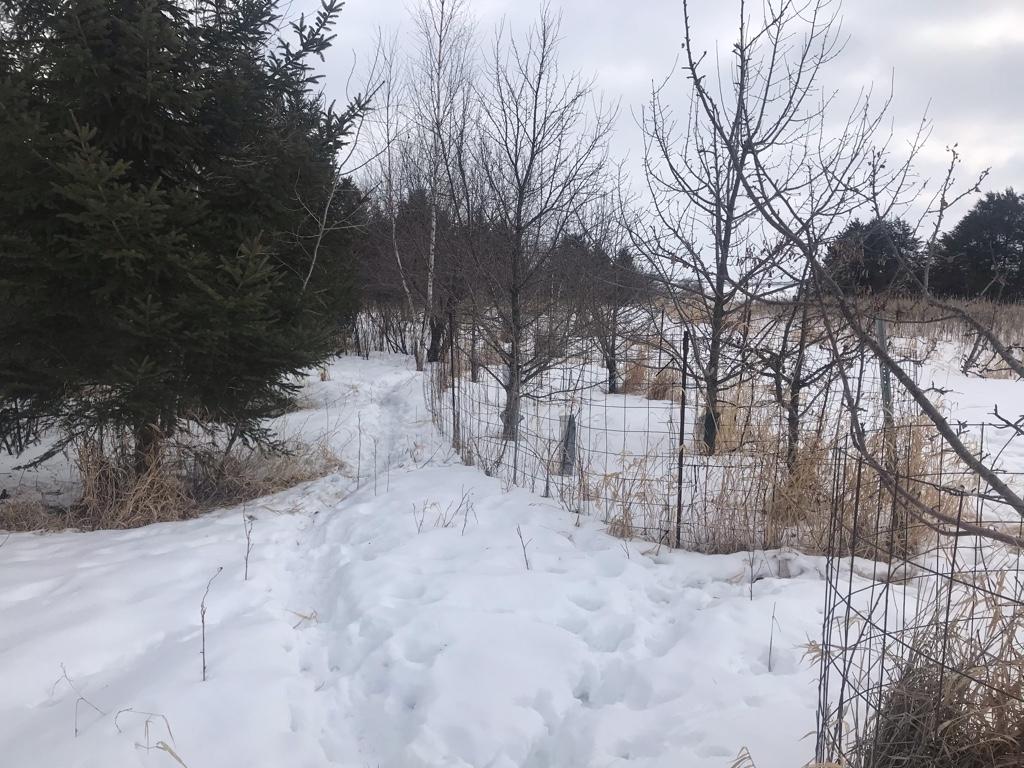westonwhitetail
5 year old buck +
Westonwhitetail you are right on about the deer actually bedding in some of the apple tree thickets and not needing to move to feed. Overall it works in our favor though just the same. Each of the apple tree thickets are different but look back a few pics to post# 6. Pictured on that post is an apple tree thicket of close to 100 apple trees maybe more. Most of the trees on either side of the planted food plot are apples. The almost solid Apple area tree wise there covers roughly four acres. As you said the trees are old (mostly about 56 years old here) and each trees' crop varies each year from very heavy to just a few. However times 100 or more trees, it makes for a lot of apples. Food plots there are mostly about 15 yards wide at the most and if put on the same line they would be four to five hundred yards long. The deer move about very freely there during daylight hours. The planted food plot areas in this thicket area are weak, simply planted in clover but the deer feel very comfortable hanging out there. That entire thicket is not from an old orchard but rather consists of wild apple trees naturally born and grown in place there. Competing non-apple trees have been reduced there over the years one by one with a chainsaw. It does take maintenance to keep it going but not as much as one would think although a few are a bit rough just the same. This is another pic of the same apple tree thicket pictured in post 6. Most of those large ugly trees are great apple producers. This young deer is walking along one of the clover food plots that runs between thickets. So as you can see there is no clover or anything planted in the thickets just either alongside them or in cleared plots that go thru them. Every thicket and plot is different.
View attachment 27817
All of the apple tree thickets growing on the property were growing there on their own when I purchased the property. The property was purchased in parcels from 1989 to about 2000. The property initially had somewhere over 3,000 wild apple trees on it then (#guesstimated). Over the years we released just over 2,000 of those apple trees(actually recorded as released and counted). There is also one planted orchard area of about twenty trees and another 6 or so here and there that we also planted. Some years there are an abundance of wild apples thru Thanksgiving but regularly less than a dozen trees are still holding good from November 15th on. And yes all of this cover with food does make hunting interesting. However and BUT all of this extra cover is where most of the areas deer spend their daylight time and most of their night time as well according to neighbor reports and number of shots heard in the area. Thus the food and cover keeps them alive. If this property were as open as the surrounding properties there would be very few bucks here over 1 1/2. Most would be dead before they even reached 2 1/2 let alone 4 1/2. Even as young deer many of them seem to prefer hanging out in this thicker cover than the very open and browsed out surrounding neighboring properties.
I have not finished detailed analyzing 2019 trail cam pics so this statistic comes from 2018. Of the 42,000 and change trail cam pics from the fall of 2018, 71% of all deer pics were daytime pics. Our targeted bucks though had a 78% rate of daytime pics. So yes the unruly thick apple tree thickets give deer all the food and cover they want so they don't need to move but it is the main cause for getting them to 3 1/2, and even 4 1/2 and sometimes 5 1/2. And per the camera pictures most of their movement occurs during daylight hours. As in all things every minus comes with pluses and every plus comes with minuses. The important thing is the chosen habitat meets our goals.
Most of the new trees to be added will be added along side the current apple tree thicket areas. It is where the deer like to be anyways so providing them with more food there via late dropping apples during the later parts of the fall and thru the winter will have more pluses than minuses. WE are usually done hunting by mid November so the major thrust is to keep the deer alive and healthy to help get them thru the year to the next age bracket.
Hope you fully get what I'm going for and sorry for the long explanation.
No thank you for the explanation. I think these thcikets would be a good tool for someone looking to add food and cover in the some area. In the right situation like yours with lots of hunting pressure, the security maybe just as valuable as the apples. I wonder if someone was trying to recreate these, if planting specific shrubs and bushes between the apple trees would be a good idea to add to it. I'm just thinking out loud, always learning and planning for when I get a larger property some day and like to add ideas to the list, I think this is a good one.




